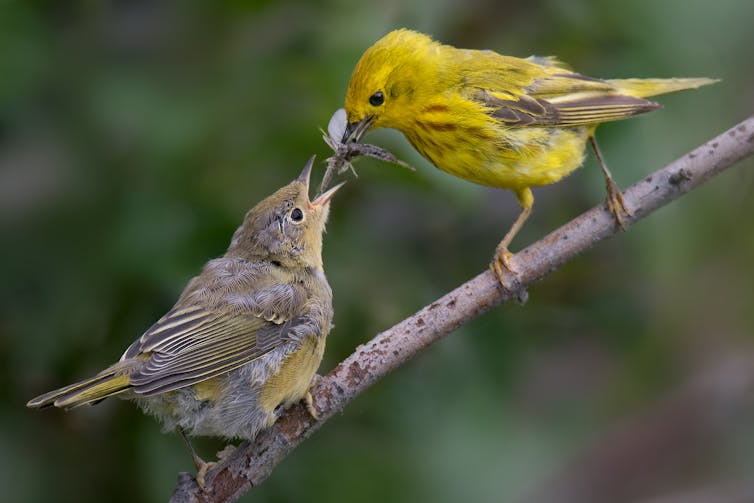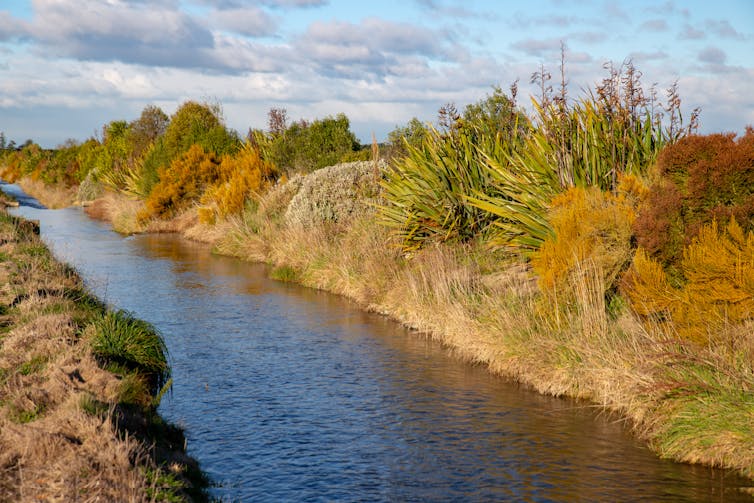Stoneflies and mayflies, canaries of our streams
- Written by Boris Kondratieff, Professor of Entomology and Curator of the C. P. Gillette Museum of Arthropod Diversity, Colorado State University
Experienced anglers recognize that for a trout, the ultimate “steak dinner” is a stonefly or mayfly. That’s why fly fishing enthusiasts will go to extreme lengths to imitate these graceful, elegant and fragile insects.
I share their passion, but for different reasons. As a an entomologist who has studied stoneflies and mayflies[1] for over 40 years, I’ve discovered these insects have value far beyond luring trout – they are indicators of water quality in streams and are a crucial piece of the larger food web. And they are in trouble.
Collecting bugs
I have served as director of the C. P. Gillette Museum of Arthropod Diversity[2] since 1986. The greatest thrill of my career has been collecting and adding mayflies and stoneflies to our collection.
 Boris Kondratieff collecting aquatic insects in Oregon with former student Chris Verdone.
Boris Kondratieff collecting aquatic insects in Oregon with former student Chris Verdone.
To find specimens, I have traveled to pristine streams in every U.S. state, Canada, Mexico, Central America, Brazil, Ecuador, the Arabian Peninsula and Europe. My collecting trips have yielded more than 100 new species of mayflies and stoneflies.
One of my favorites literally fell into my lap as I was beating lush foliage along a pristine stream in southern Oregon during May 2014. The beating sheet is an efficient means of sampling dense, streamside vegetation, where adult insects hide. The sheet itself is made of sturdy canvas stretched over two wooden cross members. A stick is used to knock the insects from the vegetation onto the canvas, where they are collected.
When I saw a large yellow and black insect drop onto my sheet, I knew immediately it was a new stonefly species, previously unknown to science. I was ecstatic. My colleagues and I subsequently described it as Kathroperla siskiyou[3], after the Siskiyou mountains of southern Oregon.
Mayflies and stoneflies thrive in unpolluted water – a fact my colleagues and I have witnessed firsthand on our numerous expeditions. Not only do we see greater overall abundance of these insects in clean streams, but more diversity of species, as well. In polluted areas, we observe the exact opposite. Without a doubt, the presence or absence of mayflies and stoneflies in a stream is a reliable indicator of the quality of its water[4].
The role of mayflies and stoneflies in the food chain is fundamental, as well. Immature mayflies and stoneflies consume algae, living plants, dead leaves, wood and each other. In this nymph phase, when they have gills and live exclusively underwater, they are an important food source for many animals further up the food chain, including fish and wading birds. When the mayflies and stoneflies emerge from the water as adults, they are essential food for spiders, other insects such as dragonflies and damselflies, and many kinds of birds and bats.
 Mayflies are on the menu for this hungry fledgling.
Keith Williams/flickr, CC BY-NC[5][6]
Mayflies are on the menu for this hungry fledgling.
Keith Williams/flickr, CC BY-NC[5][6]
Currently, scientists estimate that 33% of all aquatic insects[7] are threatened with extinction worldwide. Many of these species are mayflies and stoneflies. The mayfly species Ephemera compar has already gone extinct in Colorado[8], and several other species of aquatic insects are threatened in my home state[9].
Life drains into a stream
Less than 1% of Earth’s water is potable[10] and available for human use. Maintaining water quality has become an ever increasing challenge because of the large number of chemicals people use in everyday life and in commerce. Common contaminants such as sediment, organic enrichment including fertilizers and animal waste and heavy metals are constantly making their way into the waters[11], as well. Declining water quality is like a police siren alerting humanity to current, ongoing and emerging pollution problems.
 Native plantings along a waterway can reduce storm water runoff.
Sheryl Watson/Shutterstock.com[12]
Native plantings along a waterway can reduce storm water runoff.
Sheryl Watson/Shutterstock.com[12]
One of my great passions is to enlighten others on how to protect the most valuable natural resource of the planet: streams and rivers. Individually, citizens can make a difference. Storm water is the number one water quality problem[13] nationally. Enhancing and planting riparian buffers[14] – that is, planted areas near streams – can help to prevent precipitation and sprinkler runoff. People can also prioritize using only native plants; decreasing mowing areas; recycling or composting yard waste; using less or no fertilizer; avoiding the use of pesticides; and bagging pet waste. Insisting that environmental laws be enforced and strengthened will also help reduce water pollution.
Without clean water, life on Earth will become difficult or impossible for mayflies and stoneflies, not to mention people.
[ You’re smart and curious about the world. So are The Conversation’s authors and editors. You can read us daily by subscribing to our newsletter[15]. ]
References
- ^ studied stoneflies and mayflies (bspm.agsci.colostate.edu)
- ^ C. P. Gillette Museum of Arthropod Diversity (bspm.agsci.colostate.edu)
- ^ subsequently described it as Kathroperla siskiyou (www.researchgate.net)
- ^ is a reliable indicator of the quality of its water (www.epa.gov)
- ^ Keith Williams/flickr (www.flickr.com)
- ^ CC BY-NC (creativecommons.org)
- ^ 33% of all aquatic insects (doi.org)
- ^ Ephemera compar has already gone extinct in Colorado (www.itis.gov)
- ^ other species of aquatic insects are threatened in my home state (cnhp.colostate.edu)
- ^ Less than 1% of Earth’s water is potable (www.ngwa.org)
- ^ making their way into the waters (www.environmentalpollutioncenters.org)
- ^ Sheryl Watson/Shutterstock.com (www.shutterstock.com)
- ^ Storm water is the number one water quality problem (www.epa.gov)
- ^ riparian buffers (www.nrcs.usda.gov)
- ^ You can read us daily by subscribing to our newsletter (theconversation.com)
Authors: Boris Kondratieff, Professor of Entomology and Curator of the C. P. Gillette Museum of Arthropod Diversity, Colorado State University
Read more http://theconversation.com/stoneflies-and-mayflies-canaries-of-our-streams-126484


